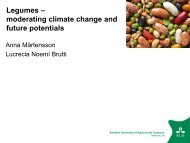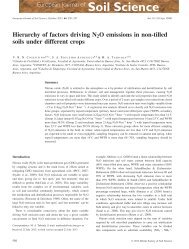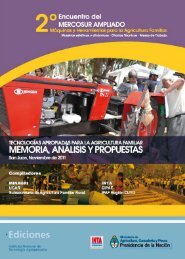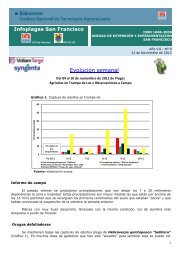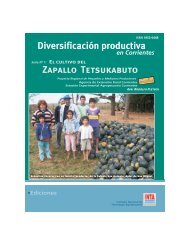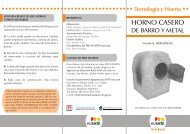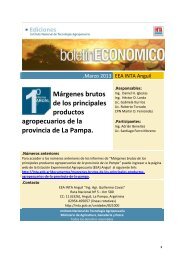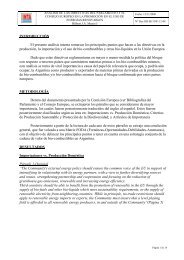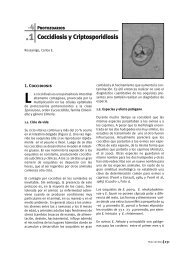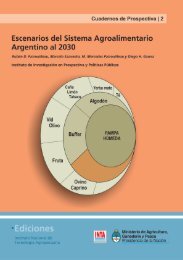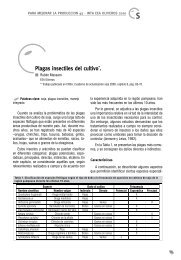Comparative movement of labelled nitrogen and zinc in 1 ... - INTA
Comparative movement of labelled nitrogen and zinc in 1 ... - INTA
Comparative movement of labelled nitrogen and zinc in 1 ... - INTA
Create successful ePaper yourself
Turn your PDF publications into a flip-book with our unique Google optimized e-Paper software.
<strong>in</strong> early Spr<strong>in</strong>g, Zn appears to be even more readily<br />
available than N.<br />
The question <strong>of</strong> Zn mobility <strong>in</strong> plants is controversial.<br />
Early observations suggested that Zn was quite<br />
immobile; however, recent studies have demonstrated<br />
extensive phloem mobility <strong>of</strong> Zn <strong>in</strong> wheat (Garnett <strong>and</strong><br />
Graham, 2005; Haslett et al., 2001; Page <strong>and</strong> Feller, 2005).<br />
At present, it appears that Zn may exhibit variable<br />
mobility (Longnecker <strong>and</strong> Robson, 1993). Experiments<br />
with apple have shown no or little <strong>movement</strong> <strong>of</strong> Zn from<br />
the leaf receiv<strong>in</strong>g the application (Orphanos, 1975);<br />
however, wheat experiments have shown extensive<br />
mobility throughout the plant (Haslett et al., 2001). Some<br />
<strong>of</strong> these differences may be due to species differences.<br />
The degree <strong>of</strong> mobility could also be <strong>in</strong>fluenced by the<br />
Zn status <strong>of</strong> the plant, thus deficient plants would not<br />
remobilise Zn well (Longnecker <strong>and</strong> Robson, 1993); <strong>and</strong><br />
by the stage <strong>of</strong> plant development (Millikan et al., 1969).<br />
For <strong>in</strong>stance, <strong>in</strong> wheat, where Zn mobility has been<br />
studied extensively, Zn appears to be quite immobile <strong>in</strong><br />
young grow<strong>in</strong>g plants. However, when flower<strong>in</strong>g <strong>and</strong><br />
seed formation beg<strong>in</strong> <strong>in</strong> mature plants, Zn mobility is<br />
<strong>in</strong>creased. Senesc<strong>in</strong>g wheat leaves export more than 50%<br />
<strong>of</strong> their Zn to develop<strong>in</strong>g seeds (Garnett <strong>and</strong> Graham,<br />
2005).<br />
One important, practical question is whether a foliar<br />
spray <strong>of</strong> Zn, under the conditions <strong>in</strong> our experiment,<br />
could effectively supply the Zn needs <strong>of</strong> a grow<strong>in</strong>g peach<br />
tree <strong>in</strong> the Spr<strong>in</strong>g. By 1 month after bloom, only about<br />
5% <strong>of</strong> Zn <strong>in</strong> the new growth was derived from the foliar<br />
application <strong>in</strong> the Autumn. This is <strong>in</strong>sufficient to<br />
ma<strong>in</strong>ta<strong>in</strong> vigorous growth, if root uptake is limited.<br />
However, the concentration <strong>of</strong> Zn used <strong>in</strong> our<br />
experiment (1 mg ml –1 ) is considerably less than typical<br />
recommended rates <strong>of</strong> 11 – 17 kg ZnSO4 (36% Zn) ha –1<br />
(Johnson <strong>and</strong> Uriu, 1989). Assum<strong>in</strong>g an application rate<br />
<strong>of</strong> 830 l ha –1 , this range <strong>of</strong> recommended rates would<br />
provide 4 – 6 mg ml –1 Zn. In addition, 68 Zn was applied<br />
only to the adaxial sides <strong>of</strong> the leaves. Thus, with higher<br />
concentrations applied both to the adaxial <strong>and</strong> abaxial<br />
leaf surfaces, it is conceivable that 8 – 12 times more Zn<br />
could be supplied to the tree. However, even that<br />
amount would still only provide 40 – 60% <strong>of</strong> the total<br />
amount <strong>in</strong> the new growth. Therefore, it appears that<br />
BOARETTO, A. E., OLIVEIRA, M. W., MURAOKA, T. <strong>and</strong> NASCIMENTO<br />
FILHO, V. F. (1998). Absorption <strong>and</strong> translocation <strong>of</strong> 65 Zn<br />
applied to common bean leaves. Journal <strong>of</strong> Nuclear Agricultural<br />
Biology, 27, 225–230.<br />
BOARETTO, A. E., BOARETTO, R.M.,MURAOKA, T., NASCIMENTO<br />
FILHO, V. F., TIRITAN, C. S. <strong>and</strong> MOURAO FILHO, F. A. A. (2002).<br />
Foliar micronutrient application effects on citrus fruit yield, soil<br />
<strong>and</strong> leaf Zn concentrations <strong>and</strong> 65 Zn mobilization with<strong>in</strong> the<br />
plant. Acta Horticulturae, 594, 203–209.<br />
BROWN,P.H.,ZHANG, Q. <strong>and</strong> BEEDE, B. (1994). Effect <strong>of</strong> foliar fertilization<br />
on <strong>z<strong>in</strong>c</strong> nutritional status <strong>of</strong> pistachio trees. Annual<br />
Report <strong>of</strong> the California Pistachio Industry, Crop Year 93–94.<br />
Fresno, CA, USA. 77–80.<br />
DEJONG,T. M., DAY,K.R.,DOYLE, J. F. <strong>and</strong> JOHNSON, R. S. (1994).The<br />
Kearney Agricultural Center Perpendicular “V” (KAC-V)<br />
orchard system for peaches <strong>and</strong> nectar<strong>in</strong>es. HortTech, 4, 362–367.<br />
E. E. SANCHEZ,S.A.WEINBAUM <strong>and</strong> R. S. JOHNSON<br />
REFERENCES<br />
843<br />
several post-harvest foliar sprays would be required to<br />
overcome severe Zn deficiency <strong>in</strong> peach trees. To fully<br />
answer this question, additional research is needed to<br />
determ<strong>in</strong>e the effect <strong>of</strong> multiple sprays, solutions <strong>of</strong><br />
different concentration, <strong>and</strong> times <strong>of</strong> application on the<br />
efficiency <strong>of</strong> Zn uptake <strong>in</strong> mature bear<strong>in</strong>g trees.<br />
We conclude that foliar applications <strong>of</strong> Zn <strong>in</strong> the<br />
Autumn are not very efficient at supply<strong>in</strong>g Zn to peach<br />
trees (< 10%), especially when compared to supply<strong>in</strong>g N<br />
as Autumn urea sprays (≥ 50%). However, once<br />
absorbed by the tree, Zn is quite mobile <strong>and</strong> is stored<br />
throughout the plant, <strong>in</strong>clud<strong>in</strong>g <strong>in</strong> the roots. Dur<strong>in</strong>g early<br />
Spr<strong>in</strong>g growth, this stored Zn is supplied to new shoot<br />
growth <strong>in</strong> greater percentages than N, especially for that<br />
portion stored <strong>in</strong> the roots. Thus, the most significant<br />
barrier to improv<strong>in</strong>g the efficiency <strong>of</strong> Zn fertilisation <strong>in</strong><br />
peach trees is gett<strong>in</strong>g adequate Zn <strong>in</strong>to the tree, not its<br />
mobility once it is <strong>in</strong> the tree. New approaches to<br />
improve the efficiency <strong>of</strong> Zn uptake would be useful.<br />
Ongo<strong>in</strong>g research is required to determ<strong>in</strong>e the<br />
quantitative significance <strong>of</strong> foliar applications <strong>of</strong> Zn,<br />
which have become a st<strong>and</strong>ard practice for many peach<br />
growers. S<strong>in</strong>ce sprays are <strong>of</strong>ten applied dur<strong>in</strong>g leaf<br />
senescence <strong>in</strong> late Autumn (Johnson <strong>and</strong> Uriu, 1989),<br />
many leaves fall to the ground before any efflux <strong>of</strong> Zn<br />
has occurred. Other leaves are <strong>in</strong>duced to abscise with<strong>in</strong><br />
1 – 2 weeks <strong>and</strong> may not have sufficient time to export<br />
the full 7 – 8% <strong>of</strong> foliar-applied Zn that may be available<br />
for export. Thus, there is a good chance that foliar<br />
applications supply substantially less <strong>of</strong> the Zn needs <strong>of</strong><br />
grow<strong>in</strong>g fruits <strong>and</strong> shoots than we have estimated above.<br />
Indeed, s<strong>in</strong>ce at least 92 – 93% <strong>of</strong> the applied Zn falls to<br />
the ground with senesc<strong>in</strong>g leaves, the greatest effect is<br />
probably on <strong>in</strong>creas<strong>in</strong>g soil Zn levels (Boaretto et al.,<br />
2002). This could <strong>in</strong>crease the availability <strong>of</strong> Zn for root<br />
uptake, but eventually could lead to problems with heavy<br />
metal contam<strong>in</strong>ation <strong>of</strong> the soil.<br />
The authors acknowledge the technical assistance <strong>of</strong><br />
Kev<strong>in</strong> Klassen <strong>and</strong> Becky Phene at the Kearney<br />
Agricultural Center, <strong>and</strong> the Interdiscipl<strong>in</strong>ary Center <strong>of</strong><br />
Plasma Mass Spectrometry, specifically Michelle Gras<br />
for her expertise <strong>in</strong> develop<strong>in</strong>g <strong>and</strong> implement<strong>in</strong>g the<br />
methodology for Zn isotope determ<strong>in</strong>ation at UC Davis.<br />
FERRANDON, M. <strong>and</strong> CHAMEL, A. R. (1988). Cuticular retention,<br />
foliar absorption <strong>and</strong> translocation <strong>of</strong> Fe, Mn <strong>and</strong> Zn supplied<br />
<strong>in</strong> organic <strong>and</strong> <strong>in</strong>organic form. Journal <strong>of</strong> Plant Nutrition, 11,<br />
247–263.<br />
GARNETT, T. P. <strong>and</strong> GRAHAM, R. D. (2005). Distribution <strong>and</strong> remobilization<br />
<strong>of</strong> iron <strong>and</strong> copper <strong>in</strong> wheat. Annals <strong>of</strong> Botany, 95,<br />
817–826.<br />
GRAUKE,L.J.,STOREY,J.B.,EMINO, E. R. <strong>and</strong> REED, D. W. (1982).<br />
The <strong>in</strong>fluence <strong>of</strong> leaf surface, leaf age, <strong>and</strong> humidity on the<br />
foliar absorption <strong>of</strong> <strong>z<strong>in</strong>c</strong> from two <strong>z<strong>in</strong>c</strong> sources by pecan.<br />
HortScience, 17, 474.<br />
HASLETT,B.S.,REID, R. J. <strong>and</strong> RENGEL, Z. (2001). Z<strong>in</strong>c mobility <strong>in</strong><br />
wheat: Uptake <strong>and</strong> distribution <strong>of</strong> <strong>z<strong>in</strong>c</strong> applied to leaves or<br />
roots. Annals <strong>of</strong> Botany, 87, 379–386.<br />
HAUCK, R. D. <strong>and</strong> BREMNER, J. M. (1976). Use <strong>of</strong> tracers for soil <strong>and</strong><br />
fertilizer research. Advances <strong>in</strong> Agronomy, 28, 219–266.



